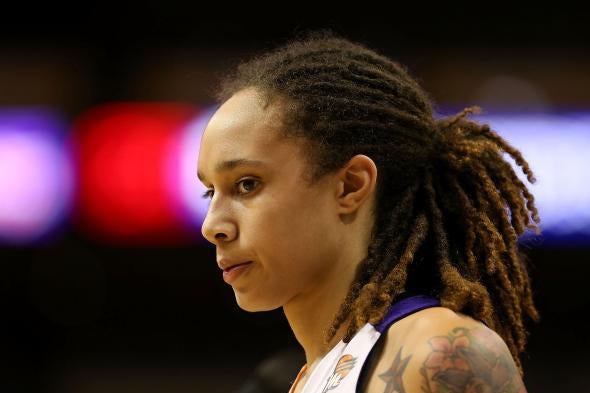This month, the WNBA became the first American pro sports league to openly recruit LGBTQ fans by launching a dedicated marketing platform, selling rainbow basketball pride T-shirts, and sponsoring pride games across the country. On June 22, ESPN2 will air the first-ever nationally televised pride game. WNBA President Laurel Richie frames the strategy as a smart business decision: Recent market research has revealed that 21 percent of lesbians have attended a WNBA game, and 25 percent have watched one on TV. For a league that’s had serious difficulties getting anyone to fill its seats, those stats are astonishing.
But they’re not really news. Lesbians have been on board since the WNBA launched in 1997, and from there “established themselves as the league’s most faithful fans,” Juliet Macur wrote in the New York Times on Tuesday. Over the past 15 years, WNBA players have led the pro sports world in openly discussing their sexuality while playing the game. In the early 2000s, WNBA player Sue Wicks stated publicly that she is a lesbian and chastised the league for only promoting the personal lives of its straight players. Sheryl Swoopes—perhaps the most famous female basketball player ever—came out soon after. And Brittney Griner, the most heralded female college player in recent memory, acknowledged that she’s gay in the press before she ever hit the court with the Phoenix Mercury in 2013. But for years, the league “pretended (at least publicly) that [lesbian] fans did not exist,” Macur writes. “The marketing was all about urging families to go to games: Dads, bring your daughters!”
Only after Jason Collins and Michael Sam broke barriers in men’s pro sports did the WNBA publicly acknowledge that it appreciates its gay and lesbian fans’ money. But, instead of drumming up enthusiasm among the league’s most dedicated, the WNBA’s belated coming out has left many of them deflated, wondering what took so long. “The gesture deserves two slow claps, considering how long it took,” Macur writes. “The league could have done this sooner, and helped change the sports world; instead, it’s merely taking advantage of a changed world.” Former WNBA TV analyst Gail Marquis told the Times: “I’m happy that they are going to have a Pride Day nationwide, but at the same time, get your head out of the sand and say, ‘We wish we would have done this much sooner.’ ” As Griner put it: “Now, with more and more athletes coming out, it’s like they had to do something.”
In 2001, the league began private discussions about whether to openly market to its lesbian fans, and the Los Angeles Sparks became the first team in any pro sports league to fully embrace the strategy by directly reaching out to fans in the LGBTQ community. (“I felt like I was a Backstreet Boy or something,” Sparks President Johnny Buss said of his enthusiastic reception after appearing at an L.A. lesbian event.) But the strategy failed to catch on around the league. In 2009, Washington Mystics managing partner Sheila Johnson said that the WNBA team doesn’t employ a Kiss Cam in the arena because “We got a lot of kids here … We just don’t find it appropriate.” College women’s basketball has been similarly slow to the uptake. Last year, founding WNBA President Val Ackerman released a report on how the NCAA can drum up interest in the sport, and though she spoke about capitalizing on fervent passion for women’s basketball overseas, she didn’t mention how to appeal to gay fans back home. Shortly after Griner’s college graduation, she spoke out about how her coaches at Baylor told lesbian players to stay in the closet to preserve the college team’s “image.” Last year, she became the first openly gay pro athlete to secure a Nike endorsement deal.
For Anita Montanile, a dedicated Connecticut Sun fan who maintains a Facebook page for the team’s LGBTQ fans, the WNBA’s shift is bittersweet. Montanile has had season tickets for the University of Connecticut Huskies, the American Basketball League (an independent women’s league that ran from 1996 to 1998), and now for the Sun, where she sits courtside. At games, she walks around the arena promoting her group to gay and lesbian fans. “There’s a big gay following of basketball,” Montanile told me. “We have a lot of disposable income, and we spend it.”
Perhaps the WNBA’s lesbian fan base is so dedicated that the league believes it can take it for granted. But “I know we can make our fan base even bigger,” Montanile says. She’s not sure why the Sun is not currently promoting a pride night on its official website or its Facebook page. And while she bought the WNBA’s new pride T-shirt featuring a rainbow-colored basketball, she was disappointed to see that its colors are a bit off from the traditional LGBTQ pride flag, which, to her, makes it look like a hedge. “I want to think that all of this is significant. But I’m not really getting excited about it. I take it with a grain of salt,” Montanile told me. “The gay fans have been here all along.”
